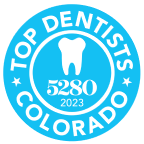While most people don’t often think about their gums, the important oral structures are essential to good oral health. Human gum tissue keeps teeth securely anchored to the jaw, so we can effectively bite and chew foods. When gums begin to recede from teeth, gum grafts restore health.
So why do gums recede? Harsh teeth brushing, tobacco use, teeth grinding, and genetics can prompt gum recession. The main culprit, however, is gum disease, also called periodontal disease. In its early stage, gum disease is called gingivitis; late-stage gum disease is known as acute periodontitis. Gum disease afflicts about half of the population and is the main cause of adult tooth loss. It also increases the risk of developing many systemic health conditions, including heart attack and stroke.
To learn about restoring receded or necrotic gum tissue, let’s explore gum grafts in more detail.
What is a gum graft?
Like a skin graft, a gum graft is the surgical application of healthy gum tissue to promote tissue regrowth in a specific area. At Metro Dental Care, our dentists place gum grafts over receded areas, and where dead or diseased tissue is missing–or where too little tissue exists, to even the gum line. As the healthy tissue graft grows to become part of the patient’s gums, it sparks the regeneration of additional healthy tissue.
Who needs a gum graft?
Besides visual recession of gum tissue, these symptoms often accompany the need for gum grafts:
- Exposed teeth roots, longer-looking teeth
- Exposed cementum (yellowish covering on teeth roots)
- Translucent, thin gum tissue
- Dental sensitivity to air, wind
- Dental sensitivity to hot/cold
What are the benefits of gum grafts?
A primary benefit of gum grafting is a reduction in dental sensitivity, but other benefits include:
- Less root decay
- Balanced, beautiful gum tissue/smile enhancement
- Healthier gums
- Bone loss/recession prevention
- Reduced risk of gum recession
What types of grafts are available?
After a comprehensive oral evaluation, your Metro Dental Care dentist may recommend one of three types of gum grafts:
- Connective-tissue graft: most common type of graft; graft is secured over exposed roots and recessed gums
- Free gingival graft: adds thickness to thin gums that aren’t in the “smile zone”
- Pedicle graft: a flap procedure treating gum recession, in patients with a sufficient amount of gum tissue
Who performs gum grafts?
Our Dr. Andrew Johns completed a residency in oral reconstruction and implant dentistry, so he performs most of the oral surgeries here in our Denver dental office. Your Metro Dental Care dentist can coordinate care with Dr. Johns to ensure a seamless, positive, and rewarding experience, as well as fantastic results.
What’s recovery like?
Every case is different, not only because the health and recovery ability of patients differs, but also because the extent of surgery varies. Expect to take a few days off work, and be sure to talk with your dentist or Dr. Johns about what your specific recovery will entail.
In preparation for recovery, purchase soft foods like yogurt, mashed potatoes, smoothies, and applesauce. You’ll need plenty of water to drink, but do not use a straw during recovery. Also avoid tobacco and smoking while your gums heal. A full list of postoperative instructions will be provided prior to your oral surgery.
Call Today for a Gum Graft Consultation
If your gums are receding or uneven gum tissue impairs your smile’s full beauty, give us a call at Metro Dental Care in Denver, at 303.534.2626. We’ll schedule your comprehensive exam and consultation so that we can answer all of your questions and find out if gum grafts will benefit you.

